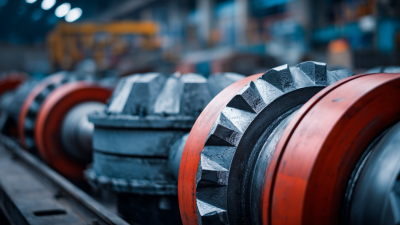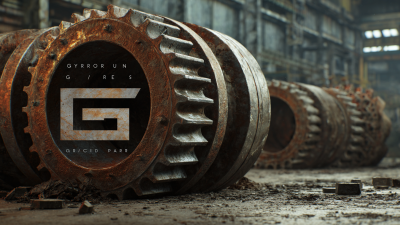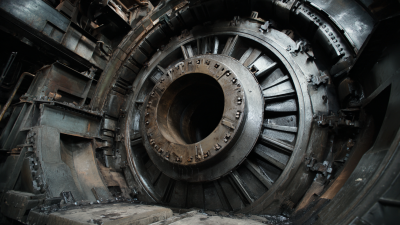
-
Home
-
About Us
-
Products
-
News
-
Blog
-
Contact Us
Leave Your Message

In today's rapidly evolving industrial landscape, the significance of Scrap Metal Recycling Wear Parts cannot be overstated. As companies seek sustainable solutions to reduce operational costs and environmental impact, innovative approaches to recycling have emerged at the forefront. According to the World Steel Association, steel recycling saves up to 74% of the energy required to produce new steel from raw materials, highlighting the economic and ecological benefits of reusing materials. Furthermore, a report from the Global Recycling Foundation indicates that the recycling of metals not only conserves natural resources but also can generate substantial revenue, with estimates suggesting an increase in market value by up to 7% annually. By leveraging advanced recycling technologies and methods for wear parts, businesses can significantly enhance profitability while contributing to a circular economy. This guide will explore strategic innovations in recycling wear parts and how they can help maximize profit in the scrap metal industry.

In recent years, the scrap metal recycling industry has seen a significant transformation driven by innovative approaches that enhance efficiency and profitability. According to a 2022 report by the Institute of Scrap Recycling Industries (ISRI), the U.S. scrap recycling industry generated over $110 billion in revenue, indicating the lucrative potential of this sector. Utilizing innovative wear parts solutions in scrap metal processing not only minimizes equipment downtime but also ensures the efficient separation and recovery of valuable metals from waste. Advanced technologies, such as AI-driven sorting systems and laser cutting, have revolutionized how scrap materials are processed, leading to higher yield rates and reduced operational costs.
Moreover, the adoption of sustainable practices within scrap metal recycling has become increasingly important. A study published by the Global Recycling Foundation highlighted that recycling one ton of aluminum saves up to 95% of the energy required to produce aluminum from raw materials. Innovative scrap metal recycling wear parts are crucial in optimizing these processes, allowing for the enhancement of recycling rates while reducing the environmental impact. By incorporating these sophisticated technologies, businesses in the recycled materials sector can not only maximize their profits but also contribute to a more sustainable industrial ecosystem.
| Material Type | Recycling Process | Wear Parts Application | Market Value ($/ton) | Profit Margin (%) |
|---|---|---|---|---|
| Aluminum | Shredding & Melting | Automotive Components | 1500 | 30 |
| Copper | Chemical Separation | Electrical Wiring | 8000 | 25 |
| Steel | Shredding & Baling | Construction Materials | 250 | 20 |
| Zinc | Melting & Purification | Galvanizing Components | 3000 | 15 |
| Brass | Thermal Processing | Pipe Fittings | 5000 | 28 |
The global stainless steel scrap market is experiencing significant growth, driven by an increasing emphasis on recycling and sustainability. According to a market research study, the demand for scrap metal recycling is projected to reach approximately USD 577.2 billion by 2034, growing at a compound annual growth rate (CAGR) of 6.5%. This trend highlights the economic impact that scrap metal recycling can have on profit margins within various industries, reflecting a stronger focus on efficient resource utilization.
In regions like Kentucky, the metals manufacturing sector is not only a major contributor to job creation but also plays a vital role in driving revenue and economic growth. The scrap metal industry has demonstrated resilience, with a valuation of the global scrap metal recycling market projected to approach USD 307.5 billion by 2024. Companies transitioning into this sector, like Greenwave Technology Solutions, emphasize innovative wear parts solutions, embracing technology to enhance efficiency and profitability in recycling operations.
These developments underline the importance of strategic investment in scrap metal recycling as a pathway to maximizing profit margins in an increasingly competitive landscape.
 In the ever-evolving landscape of scrap metal recycling, the adoption of
advanced wear parts solutions is crucial for enhancing
efficiency and maximizing profit margins. Innovative wear parts are engineered to withstand the harsh
conditions of recycling environments, reducing downtime and maintenance costs. By implementing these
cutting-edge solutions, businesses can significantly improve their operational workflows, ensuring that
recycling processes are not only effective but also cost-efficient.
In the ever-evolving landscape of scrap metal recycling, the adoption of
advanced wear parts solutions is crucial for enhancing
efficiency and maximizing profit margins. Innovative wear parts are engineered to withstand the harsh
conditions of recycling environments, reducing downtime and maintenance costs. By implementing these
cutting-edge solutions, businesses can significantly improve their operational workflows, ensuring that
recycling processes are not only effective but also cost-efficient.
Moreover, integrating smart technologies into wear
parts design allows for real-time monitoring and performance tracking. This data-driven approach helps
recyclers optimize equipment functionality, leading to increased throughput and reduced energy consumption.
As companies explore these advanced wear parts solutions, they are better positioned to meet the
growing demand for sustainable practices while also achieving greater financial returns. The synergy
between innovation and recycling operations can redefine profitability in the scrap metal industry,
paving the way for a more sustainable future.
In today’s rapidly evolving recycling industry, leveraging technology is paramount for optimizing scrap metal collection and processing. According to the World Steel Association, approximately 30% of global steel production comes from recycled scrap, underscoring the immense potential for creating sustainable systems in metal processing. Advanced technologies such as IoT sensors and AI-driven analytics facilitate smarter operations by allowing companies to monitor scrap material flow, predict demand, and optimize inventory management in real-time. This technological integration not only enhances efficiency but also lowers operational costs.

Furthermore, the adoption of automated sorting technologies has revolutionized scrap metal recycling. Reports from the Institute of Scrap Recycling Industries indicate that automation can increase sorting efficiency by up to 50%, significantly improving the quality and grade of recycled materials. As firms invest in robotics and AI, they can streamline the processing chain, resulting in higher profit margins and reduced environmental impact. The future of scrap metal recycling lies in the synergy of innovative technologies, enabling companies to maximize profits while contributing to a circular economy.
Implementing sustainable scrap metal recycling strategies is crucial for industries seeking to maximize their profitability while minimizing environmental impact. The recent focus on developing innovative solutions, such as optimizing collection processes and employing advanced recycling technologies, can significantly enhance metal recovery rates. For instance, adopting strategies similar to those seen in the UAE, where resource-sharing and zero-waste goals are emphasized, can create symbiotic relationships among businesses, leading to more efficient operations and reduced waste.
Moreover, aligning with global initiatives, such as India’s Steel Scrap Recycling Policy and expanding recycling capabilities for energy-transition metals, can unveil new market opportunities. As the metal recycling market is projected to grow substantially, industries must prioritize sustainable practices that not only meet regulatory demands but also resonate with environmentally-conscious consumers. By embracing best practices in scrap metal recycling, businesses can foster long-term viability and contribute to a circular economy that benefits both the economy and the environment.





